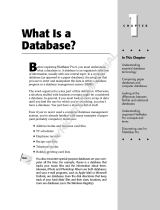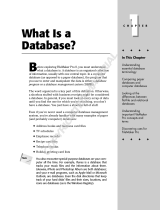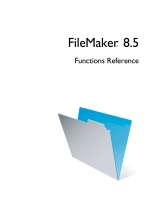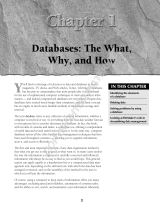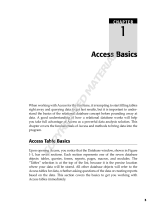Page is loading ...

©1990, 1992, 1995, 1997 Claris Corporation. All Rights Reserved.
Claris Corporation
5201 Patrick Henry Drive
Santa Clara, California 95054
http://www.claris.com
Claris, ClarisImpact, ClarisWorks, FileMaker, and ScriptMaker are trademarks of Claris Corporation,
registered in the U.S. and other countries, and Claris Home Page is a trademark of Claris Corporation.
Apple, AppleScript, AppleShare, AppleTalk, HyperCard, Mac, Macintosh, Macintosh Quadra, and
QuickTime are trademarks of Apple Computer, Inc., registered in the U.S. and other countries. All other
trademarks are the property of their respective owners.
Portions of the software are © 1990 Access Softek
This software is based in part on the work of the Independent JPEG Group.
Mention of third party companies and products is for informational purposes only and constitutes neither an
endorsement nor recommendation.
All persons and companies listed in the examples are purely fictitious and any resemblance to existing
persons and companies is purely coincidental.
FOR WINDOWS

Contents
III
Contents
Preface: Getting help
Customer support and registration
XIII
Using Help and the user’s guide together
XIII
Using FileMaker Pro Help
XIV
Opening FileMaker Pro Help
XIV
Managing FileMaker Pro Help
XIV
Using the Help contents
XV
Using the Help window
XVI
Using the Help index
XVI
Using Find
XVIII
Getting additional help
XIX
Using the FileMaker Pro documentation
XIX
Chapter 1: FileMaker Pro basics
Understanding FileMaker Pro
1-1
What’s a database?
1-1
What’s a FileMaker Pro database file?
1-4
Fields and field definitions
1-4
Records
1-5
Access privileges and passwords
1-6
Using relationships in a database
1-6
Working with modes
1-7
Managing files
1-9
Creating and opening files
1-9
Closing files
1-11
Saving a copy of a file
1-11
Leaving FileMaker Pro
1-13
Checking your spelling
1-13
Checking your spelling in a file
1-13
Checking your spelling as you type
1-14
Working with spelling dictionaries
1-15
Selecting a spelling dictionary
1-16
Making changes to a user dictionary
1-17

IV
FileMaker Pro User’s Guide
Chapter 2: Creating a database file
Planning a database file
2-1
Defining database fields
2-3
Assigning a field type
2-4
Choosing data entry options
2-6
Defining global fields
2-9
Defining repeating fields
2-10
Indexing fields
2-11
Understanding formulas
2-13
Expressions
2-14
Constants
2-14
Field references
2-15
Operators
2-15
Stored and unstored calculation results
2-19
Functions
2-20
Writing formulas for calculation fields
2-20
Defining summary fields
2-23
Changing field definitions
2-25
Chapter 3: Laying out and arranging information
Understanding layouts
3-1
Working with predefined layout types
3-4
Using Standard, Single-page form, and Blank layouts
3-7
Using Columnar report and Extended
columnar layouts
3-9
Using Labels layouts
3-11
Using Envelope layouts
3-17
Arranging records in columns
3-20
Managing layouts
3-23
Working with layout parts
3-24
Adding layout parts
3-26
Adding objects to a layout part
3-29
About summary layout parts
3-29
Adding a summary part
3-30
Paginating a layout
3-32
Changing layout parts
3-35
Reordering parts
3-35
Resizing parts
3-36
Changing part types and options
3-36
Deleting layout parts
3-36

Contents
V
Working with all object types
3-37
Working with the drawing tools
3-38
Positioning and sizing objects
3-39
Editing objects and data quickly using the
context menu
3-42
Showing button, text, and field boundaries
3-43
Arranging objects
3-43
Changing the appearance of objects
3-48
Protecting objects from change
3-51
Working with graphic objects
3-51
Drawing objects in a layout
3-51
Adding graphics in a layout
3-52
Working with fields in a layout
3-53
Adding fields to a layout
3-54
Adding merge fields
3-56
Deleting a field from a layout
3-57
Defining display formats for fields
3-58
Determining data entry in fields
3-67
Setting the tab order for data entry
3-68
Adding scroll bars to fields
3-70
Formatting repeating fields
3-71
Adding borders, fill, and baselines to fields
3-72
Defining value lists
3-74
Formatting fields with value lists
3-76
Working with text
3-78
Typing text
3-79
Selecting text
3-80
Editing text
3-81
Displaying special information
3-81
Formatting text paragraphs
3-82
Changing the appearance of text
3-86
Changing several text attributes at once
3-87
Chapter 4: Working with information in records
Working in Browse mode
4-1
Adding data to a file
4-3
Selecting a field for data entry
4-3
Adding and duplicating records
4-3
Entering and changing data in fields
4-4
Working with container fields
4-6

VI FileMaker Pro User’s Guide
Entering data from a value list 4-9
Viewing and inserting data from another source 4-10
Copying and moving values and records 4-12
Using drag and drop to move information 4-13
Replacing field values 4-15
Working with records 4-17
Browsing records 4-17
Moving through records 4-18
Finding information 4-19
Defining find requests 4-19
Finding information in different field types 4-22
Finding different sets of criteria 4-24
Repeating, editing, and deleting find requests 4-25
Omitting records 4-25
Copying the found set 4-28
Deleting records 4-28
Sorting records 4-29
Sorting by summary fields 4-32
Chapter 5: Using ScriptMaker and buttons
Understanding scripts 5-1
Understanding ScriptMaker steps 5-3
Control steps 5-4
Navigation steps 5-5
Sort, find, and print steps 5-5
Editing steps 5-6
Fields steps 5-6
Records steps 5-7
Import and export steps 5-7
Windows steps 5-8
Files steps 5-8
Spelling steps 5-9
Open Menu Item steps 5-9
Miscellaneous steps 5-10
Planning scripts 5-10
Defining scripts 5-12
Storing settings for a script 5-14
Changing and duplicating scripts 5-15
Reordering scripts in the Script menu 5-16
Deleting scripts 5-17

Contents VII
Performing, resuming, or stopping scripts 5-17
Using buttons with scripts 5-18
Defining buttons 5-19
Copying, changing, or deleting buttons 5-21
Examples of ScriptMaker scripts 5-21
Entering and printing data 5-21
Finding data 5-23
Displaying customized layouts 5-25
Finding duplicate records 5-26
Chapter 6: Previewing and printing information
Preparing to print 6-1
Displaying margins 6-2
Setting margins 6-3
Removing spaces at the end of fields and parts 6-5
Keeping objects from printing 6-9
Printing Extended columnar layouts 6-9
Printing layouts with subsummaries 6-10
Printing labels and envelopes 6-10
Previewing before printing 6-10
Printing 6-11
Specifying a printer 6-13
Chapter 7: Networking and access privileges
Sharing files 7-1
Opening files as the host 7-3
Opening files as a guest 7-4
Working with shared files 7-5
Closing shared files 7-7
Protecting your files 7-8
Defining passwords 7-10
Deleting or changing passwords 7-14
Defining groups 7-14
Deleting or changing groups 7-17
Chapter 8: Importing and exporting data
Understanding import and export 8-1
Understanding file formats 8-3

VIII FileMaker Pro User’s Guide
Importing data into FileMaker Pro 8-4
Importing data into an existing file 8-5
Importing data into a new file 8-9
Exporting data from FileMaker Pro 8-9
Exporting subsummary data 8-12
Exporting repeating field data 8-14
Chapter 9: Customizing FileMaker Pro
Setting application preferences 9-1
Setting general application preferences 9-2
Setting layout preferences 9-3
Setting memory preferences 9-4
Setting preferences for dialing phone numbers 9-5
Setting up plug-ins 9-8
Setting document preferences 9-8
Setting document spelling preferences 9-10
Setting Web Companion preferences 9-10
Chapter 10: Using data from related files
Looking up and displaying data from other files 10-1
Understanding the terminology 10-2
Understanding lookups 10-3
Understanding relational databases 10-5
Lookups and relational databases: a comparison 10-8
Understanding relationships 10-9
Defining lookups between files 10-11
Defining a lookup 10-11
Defining a relationship for a lookup 10-13
Updating lookup values 10-14
Working with relational databases 10-14
Planning a relational database 10-15
Creating a relational database 10-20
Deciding where to place related fields 10-20
Defining relationships for a relational database 10-21
Creating a portal to hold related fields 10-23
Placing related fields in a layout or portal 10-25
Changing related fields and portals 10-26
Selecting, moving, or deleting related fields
and portals
10-27

Contents IX
Changing the appearance of related fields
and portals
10-27
Copying and pasting related fields and portals 10-28
Choosing a different relationship for a portal 10-28
Changing relationships 10-28
Working with related files and fields 10-30
Working with related files 10-30
Working with related fields 10-30
Working with related records 10-31
Creating related records 10-32
Deleting related records 10-34
Finding and omitting related records 10-34
Sorting records with related fields 10-35
Invoicing example 10-36
Example step 1: Plan the system 10-37
Example step 2: Define fields 10-40
Example step 3: Define relationships 10-41
Example step 4: Define fields that use relationships 10-41
Example step 5: Create layouts 10-42
Example step 6: Enter data 10-42
Chapter 11: Publishing files on the Web
About the World Wide Web 11-1
About FileMaker Pro Web Companion 11-1
What the Web Companion does 11-2
Why publish a database on the Web? 11-3
Publishing your database on the Web—an overview 11-3
Instant Web Publishing 11-3
Custom Web Publishing 11-4
Getting ready to publish your files on the Web 11-5
Internet access 11-5
Preparing files for the Web 11-5
Security considerations before you publish
a database
11-6
Setting up FileMaker Pro Web Companion 11-7
Configuring FileMaker Pro Web Companion 11-8
Enabling Instant Web Publishing 11-9
Specifying a home page for your database 11-9
Choosing a language 11-10
Creating a Web activity log 11-10

X FileMaker Pro User’s Guide
Remote password administration 11-10
Web security 11-11
Specifying a port number 11-11
Setting up Instant Web Publishing 11-12
Setting options for Web display 11-12
Setting sort options 11-13
About the browser views 11-14
Database security 11-18
FileMaker Pro access privileges 11-18
Web Security database 11-19
Web Security database remote password
administration
11-22
Helping Web users find your database 11-22
Custom Web Publishing 11-24
The CDML Reference database 11-24
The CDML Tool 11-25
Sample Web solutions 11-27
Appendix A: Recovering damaged files A-1
Appendix B: Working with international files
Using the current system formats B-1
Defining scripts for system formats B-3
Appendix C: Summary of functions
Understanding functions C-1
Text functions C-3
Number functions C-4
Date functions C-5
Time functions C-6
Aggregate functions C-6
Summary functions C-9
Repeating functions C-11
Financial functions C-12
Trigonometric functions C-13
Logical functions C-14
Status functions C-16
Design functions C-18
FileMaker Pro Web Companion external functions C-19

Contents XI
Appendix D: Linking and embedding objects
Understanding Object Linking and Embedding D-1
Adding OLE objects to your database D-3
Working with OLE objects D-6
Showing OLE objects D-6
Copying and pasting OLE objects D-7
Activating and deactivating OLE objects D-7
Editing OLE objects D-9
Updating and changing links D-9
Converting OLE objects to a different format D-11
Working with OLE on a network D-12
Index I-1

Preface: Getting help
Welcome to the FileMaker Pro application from Claris Corporation.
FileMaker Pro is designed to help you manage information easily
and effectively.
If you’re new to Microsoft Windows you need to learn about Windows
conventions and using the mouse and keyboard. See the documentation
that came with your computer.
Important If you are using a Windows operating system other than
Windows 95 (such as Windows NT, Windows 3.1, or Windows for
Workgroups), what you see on your screen might not match the illustrations
in the documentation.
Customer support and registration
Please take the time to complete and mail the product registration
card that is included in this package. Refer to our Web site at
http://www.claris.com for information about customer support.
U.S. and Canadian retail customers can also refer to the Claris Service
Directory included with the software. For customers outside of the U.S.
or Canada, refer to the Technical Support brochure included with
the software.
Using Help and the user’s guide together
Throughout this guide you see Help icons in the margin, along with
instructions, that tell you what keywords to use to find a related Help
topic. A keyword is like a term in an index. In some cases, Help gives
you additional information about a subject. For more information about
using Help keywords, see “Using the Help index” on page XVI.
Use the FileMaker Pro Quick Reference on the back cover of this user’s
guide to get at-a-glance information about using the FileMaker Pro tools
and status area controls.
Choose FileMaker Help Index from the Help menu, and then type:
E Help, using
?

XIV FileMaker Pro User’s Guide
Glossary terms are available in the Help Reference section, as well as
underlined with a dotted line in Help topics.
Note The examples in this documentation show dates and numbers in
U.S. formats such as November 30, 1998 and $1,234.50.
Using FileMaker Pro Help
FileMaker Pro Help is available whenever FileMaker Pro is running. It
contains some information not in the printed documentation, like
troubleshooting tips. As you get comfortable with FileMaker Pro, you’ll
be able to find all the information you need in FileMaker Pro Help.
Opening FileMaker Pro Help
To open Help when FileMaker Pro is running, choose a command from
the Help menu:
Keep these points in mind:
1 Whenever you open FileMaker Pro Help, you start the Windows
Help application, which runs independently of FileMaker Pro.
1 As you move your pointer in the FileMaker Pro window, notice the
status bar help—text at the bottom of the window that gives brief
descriptions of FileMaker Pro tools, icons, and menus.
Managing FileMaker Pro Help
Here are some ways to manage FileMaker Pro Help and the windows on
your screen:
Choose To see
FileMaker Help A Help pointer with which you can get context-sensitive Help
FileMaker Help Topics Topic titles in a table of contents
FileMaker Help Index An alphabetical list of index entries (keywords)
About FileMaker Pro Version, copyright information, and other details about this
release of FileMaker Pro
To Do this
Work in FileMaker Pro while
FileMaker Pro Help is running
Start FileMaker Pro or click a FileMaker Pro window.
Move a window Drag the window’s title bar.

Getting help XV
Using the Help contents
When you open FileMaker Pro Help, you see a list of Help topics, like
the table of contents in a book. You can double-click topic titles (with
book icons) to see any subtopics, and then double-click topics (with
document icons) to move to the information you need.
Arrange windows for
easy access
Click the right mouse button in an open area on the task
bar, and then click Cascade, Tile Horizontally, or Tile Vertically.
Switch between the Help
window and a FileMaker Pro
file window
Click the window you want to work with.
Keep the Help window on top
of all other open windows
Choose Keep Help on Top from the Options menu in the
Help window.
Close FileMaker Pro Help and
leave it running
Click the minimize button in the upper-right corner of the
window. Windows Help continues to run in the
background. To show Help again, click the FileMaker Pro
Help button in the task bar.
Exit FileMaker Pro Help and
the Windows Help application
Click the Help window to make it active, and then choose
Exit from the File menu.
To Do this

XVI FileMaker Pro User’s Guide
Using the Help window
To navigate in the Help system, you click buttons and underlined text in
the Help window.
Click solid underlined text to jump to a topic related to the current topic.
To return to any topic you viewed during a help session, choose Display
History Window from the Options menu, and then double-click the topic title.
Using the Help index
FileMaker Pro Help comes with a list of index entries, which are
significant words and phrases (called keywords), to help you find the
topics containing the information you want. Each index entry is
associated with one or more topics.
This user’s guide gives you keywords throughout the documentation to
help you find related topics by their index entries in Help.
Displays the title of
the current topic
Click to see the index
Click to move to the
next or previous topic
Cli
c
k
to return to t
h
e
l
ast top
i
c v
i
ewe
d
Click to return to
the help contents
Click dotted
underlined
text to see a
definition
Click to print
the topic

Getting help XVII
To use the Help index:
1. If you aren’t in Help, choose FileMaker Help Index from the Help menu.
2. In the Index window, type all or part of the keyword to find.
You see the keywords in the list.
3. Select the keyword you want and click Display.
1 If only one topic corresponds to the keyword, you see that topic.
1 If more than one topic matches the keyword, you see a list of
the matching topics in the Topics Found window. Select a topic and
click Display.
To browse the index, scroll
through the alphabetical list or
type the first few letters of the
entry you’re looking for
Click to create a list to
use for searching on
specific words and
phrases in topics

XVIII FileMaker Pro User’s Guide
Using Find
You can search for specific words in FileMaker Pro Help:
1. Click the Find tab.
The first time you do this, the Find Setup Wizard dialog box appears.
Follow the instructions it provides.
2. Type the word or words you want to search for in box 1.
3. If you want, select some matching words in box 2 to narrow your
search. You can hold down Ctrl to select more than one matching
word.
4. In box 3, click a topic, then click Display.
Click to find a specific
word
Type the word you want
Select one or more
matching words if you want
Click the topic you want to
see, then click Display

Getting help XIX
Getting additional help
To get context-sensitive help for menu items, dialog boxes, tools, and
screen elements, press F1 or Shift-F1. Pressing Shift-F1 displays a
pointer you can use to click on areas of the screen not available when
you press F1.
Use Help to get information on these additional tasks:
Using the FileMaker Pro documentation
This guide and the other documentation in the set give you all the
information you need to know about installing and using FileMaker Pro.
Start by reading chapter 1, “FileMaker Pro basics,” for an overview of
FileMaker Pro, and for information about managing files and
performing common tasks. Then read chapter 2, “Creating a database
file,” for information about designing FileMaker Pro database files. You
can then move to the chapters you need for doing your work, such as
using layouts, or entering, finding, and sorting information.
Use the following additional tools to help you with FileMaker Pro.
For information on
Choose FileMaker Help Index from
the Help menu, and then type
Printing a Help topic Help, printing
Adding your own notes or instructions to a
topic (annotations)
Help, customizing
Creating bookmarks to quickly access topics you
use often
Help, customizing
Copying all or part of a topic to an application
that supports text, to compile help information
you use often
Help, using
Setting Help preferences to customize the way
you use Help
Help, customizing
Use To
FileMaker Pro
Installation and New
Features Guide
Install FileMaker Pro on your hard disk. If you’ve used
previous versions of FileMaker Pro, you can read about
features new to this version.
FileMaker Pro Tutorial
(an onscreen tutorial)
To get an overview of how to use and design a FileMaker Pro
database. You can complete the tutorial in one session, or one
segment at a time. To use the tutorial, double-click the Tutorial
file in the Tutorial folder.

XX FileMaker Pro User’s Guide
FileMaker Pro
template files
See and work with database files created with FileMaker Pro.
You can use the templates for your business or personal work—
as they are, or change them to suit your needs. (See “Creating
and opening files” on page 1-9.)
FileMaker Pro Help Get complete, onscreen, step-by-step instructions and reference
information for using FileMaker Pro as you work. (See “Using
FileMaker Pro Help” on page XIV.)
Status Bar Help See brief descriptions of FileMaker Pro tools, icons, and
menus. As you move your pointer in the window, the text at the
bottom of the window changes.
CDML Developer’s Guide Get information on publishing custom Web database solutions.
Open the CDML Reference.fp3 file in the Web Tools folder, in
the FileMaker Pro 4.0 folder.
Web browser Help Get help while working with a database in a browser. Available
by clicking the ? icon in the Instant Web Publishing interface.
Sample custom HTML
pages and databases
Use as models for creating your own custom Web databases.
Available in the Web folder, in the FileMaker Pro 4.0 folder.
Use To

Chapter 1: FileMaker Pro basics
You’re using FileMaker Pro software because you have information to
manage, or information you would like to publish on the World Wide
Web. This information could be just about anything: accounts,
inventories, suppliers, sales contacts, employees, or products. The
power, flexibility, and ease of use of FileMaker Pro help you manage
that information, so you can:
1 find information quickly
1 update and maintain information
1 print documents like invoices, form letters, and mailing labels
1 analyze information using onscreen and printed reports
Important Before you read this chapter, be sure you know how to use
FileMaker Pro Help, as explained in the preface, “Getting help.”
Understanding FileMaker Pro
Before you begin to work with FileMaker Pro, you should be familiar
with the basics of FileMaker Pro. If you’re new to databases, start with
the next section, “What’s a database?” If you’re familiar with databases
but new to FileMaker Pro, start with “What’s a FileMaker Pro database
file?” on page 1-4.
What’s a database?
A database is a collection of information, or data, that you can organize,
update, sort, search through, and print as needed. A database doesn’t just
hold information—you use a database to organize and analyze
information so that you understand its significance.
A database can be one file, such as Clients, which might hold the names,
addresses, and phone and fax numbers of all your clients.
A database can also be many files that, together, contain all the
information about a particular topic, or related topics (sometimes called
a database system). For example, a database for a travel agency can
include files that hold information about clients, tours, invoices,
and accounting.

1-2 FileMaker Pro User’s Guide
Using the relational capabilities of FileMaker Pro, you can join
information between files to create a relational database. For example,
one file can show you which clients went on a particular tour and a
related file can show how much they paid. (For more information about
relational databases, see chapter 10, “Using data from related files.”)
Trip file
Clients file
Invoice file
/
